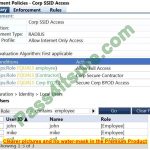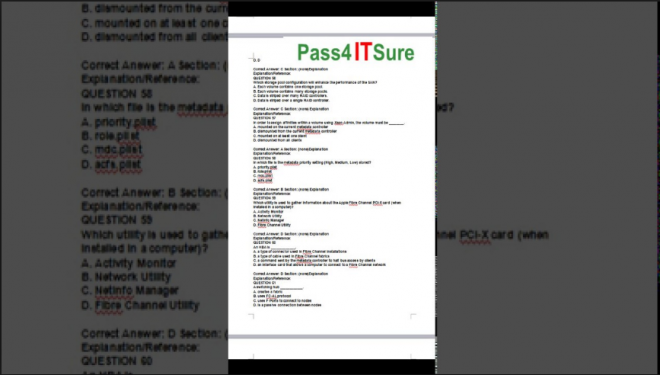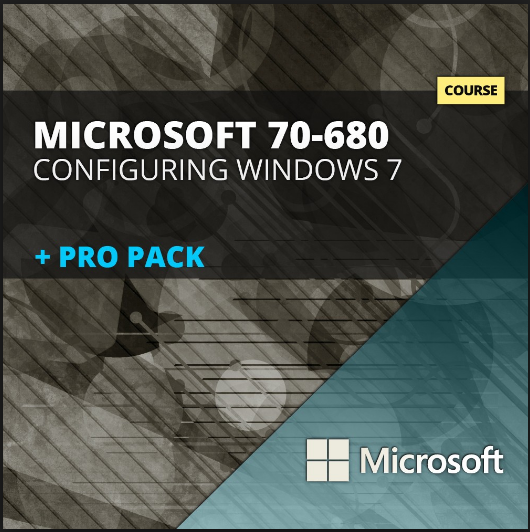The Microsoft 70-680 exam is a computer-based test containing approxmiately 50-80 multiple-choice questions. The 70-680 exam completes the requirements for the Microsoft Certified Technology Specialist (MCTS): Windows 7, Configuration certification, and credits towards the Microsoft Certified Solutions Associate (MCSA): Windows 7 and Microsoft Certified IT Professional (MCITP): Enterprise Desktop Support Technician 7 certifications.
Exam Code: 70-680
Exam Name: TS:Windows 7,Configuring
Updated: Apr 12, 2017
Q&As: 565
Exam Information:https://www.pass4itsure.com/70-680.html
The Pass4itsure covers installing, upgrading, and migrating Windows; deploying Windows; installing and troubleshooting drivers; troubleshooting compatibility problems with applications; configuring network settings including the Windows Firewall; managing disks; and recovering Windows in case of a failure or problem. While the 70-680 exam is a comprehensive exam, it tends to give a little bit more focus on newer technologies introduced or modified in Windows 7.
70-680 Exam Section 1: Installing, Upgrading, and Migrating to Windows 7
|
1.1 – Windows 7 Editions (12:38)
1.2 – Windows 7 Installation Sources (23:00) 1.3 – Windows 7 Clean Installation (13:17) 1.4 – Windows 7 Dual-Boot Installation (23:53) 1.5 – Upgrading to Windows 7 (19:49) 1.6 – Migrating User Profiles with Windows Easy Transfer (14:20) 1.7 – Migrating User Profiles with the User State Migration Tool (13:00) |
70-680 Exam Section 2: Deploying Windows 7
|
2.1 – Deploying Windows 7 (9:06)
2.2 – Creating a Reference Image (20:40) 2.3 – Capturing an Image (15:56) 2.4 – Preparing for Deployment (25:17) 2.5 – Deploying a System Image (32:37) 2.6 – Working with Virtual Hard Disks (28:21) |
Latest 70-680 PDF Exam Questions and Answers Updated (March 2017)#1-7
QUESTION 1
Your network consists of an Active Directory domain and a DirectAccess infrastructure.
You install Windows 7 on a new portable computer and join the computer to the domain.
You need to ensure that the computer can establish DirectAccess connections.
What should you do?
A. Install a computer certificate.
B. Create a new network connection.
C. Enable the Network Discovery firewall exception.
D. Add the computer account to the Network Configuration Operators group.
Correct Answer: A
Explanation
Explanation/Reference:
Explanation:
Certificates
The DirectAccess IPsec session is established when the client running Windows 7 and the DirectAccess
server authenticate with each other using computer certificates. DirectAccess supports only certificate
based authentication.
DirectAccess Client Configuration
Clients receive their DirectAccess configuration through Group Policy. This differs from traditional VPN
configuration where connections are configured manually or distributed through the connection manager
administration kit. Once you have added the computer’s client account to the designated security group,
you need to install a computer certificate on the client for the purpose of DirectAccess authentication. An
organization needs to deploy Active Directory Certificate Services so that clients can automatically enroll
with the appropriate certificates.
QUESTION 2
You have a portable computer named Computer1 that runs Windows 7.
You have a file server named Server1 that runs Windows Server 2008. Server1 contains a shared folder
named Share1.
You need to configure Computer1 to meet the following requirements:
Ensure that cached files from Share1 are encrypted.
Ensure that files located in Share1 are available when Server1 is disconnected from the network.
What should you do?
A. On Server1, encrypt the files in Share1. On Computer1, make Share1 available offline.
B. On Server1, configure BitLocker Drive Encryption. On Computer1, make Share1 available offline.
C. On Computer1, make Share1 available offline and enable encryption of offline files.
D. On Computer1, copy the files from Share1 to the Documents library and configure BitLocker Drive
Encryption.
Correct Answer: C
Explanation
Explanation/Reference:
Explanation:
Offline Files
The Offline Files feature of Windows 7 allows a client to locally cache files hosted in shared folders so that
they are accessible when the computer is unable to connect directly to the network resource. The Offline
Files feature is available to users of the Professional, Enterprise, and Ultimate editions of Windows 7. You
can use the Offline Files feature to ensure access when a client computer is out of the office or when a
temporary disruption, such as a wide area network (WAN) link failing between a branch office and a head
office, blocks access to specially configured shared folders.
Using Sync Center
You can use Sync Center to synchronize files, manage offline files, and resolve synchronization conflicts
manually. Sync Center is located within the Control Panel or by typing Sync Center into the Search
Programs and Files text box on the Start menu. Clicking Manage Offline Files opens the Offline Files. This
dialog box is also available using the Offline Files control panel. Using this dialog box, you can disable
offline files, view offline files, configure disk usage for offline files, configure encryption for offline files, and
configure how often Windows 7 should check for slow network conditions
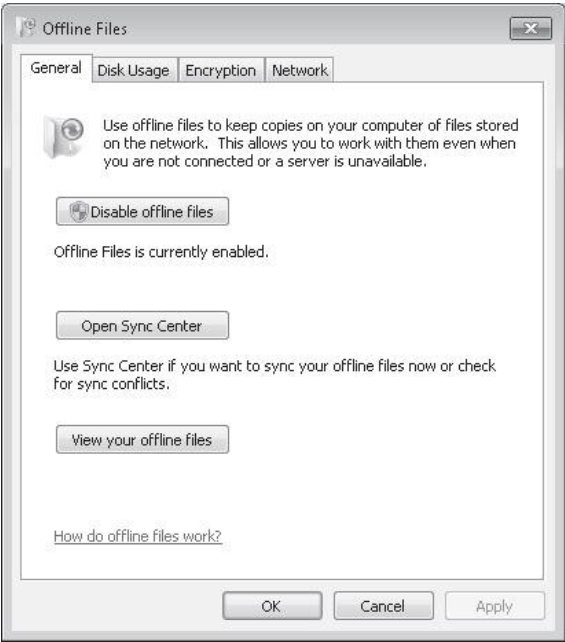
QUESTION 3
You have a computer named Computer1 that runs Windows Vista and a computer named Computer2 that
runs Windows 7. You plan to migrate all profiles and user files from Computer1 to Computer2.
You need to identify how much space is required to complete the migration.
What should you do?
A. On Computer1 run Loadstate c:\store /nocompress
B. On Computer1 run Scanstate c:\store /nocompress /p
C. On Computer2 run Loadstate \\computer1\store /nocompress
D. On Computer2 run Scanstate \\computer1\store /nocompress /p
Correct Answer: B
Explanation
Explanation/Reference:
Explanation: 70-680 exam
ScanState
You run ScanState on the source computer during the migration. You must run ScanState.exe on
computers running Windows Vista and Windows 7 from an administrative command prompt. When running
ScanState on a source computer that has Windows XP installed, you need to run it as a user that is a
member of the local administrators group. The following command creates an encrypted store named
Mystore on the file share named Migration on the file server named Fileserver that uses the encryption key
Mykey: scanstate \\fileserver\migration\mystore
/i:migapp.xml /i:miguser.xml /o /config:config.xml /encrypt /key:”mykey”
Space Estimations for the Migration Store
When the ScanState command runs, it will create an .xml file in the path specified. This .xml file includes
improved space estimations for the migration store. The following example shows how to create this .xml
file: Scanstate.exe C:\MigrationLocation [additional parameters]
/p:”C:\MigrationStoreSize.xml” To preserve the functionality of existing applications or scripts that require
the previous behavior of USMT, you can use the /p option, without specifying “pathtoafile”, in USMT 4.0. If
you specify only the /p option, the storage space estimations are created in the same manner as with
USMT 3.x releases.
User State Migration Tool
USMT 4.0 is a command-line utility that allows you to automate the process of user profile migration. The
USMT is part of the Windows Automated Installation Kit (WAIK) and is a better tool for performing a large
number of profile migrations than Windows Easy Transfer. The USMT can write data to a removable USB
storage device or a network share but cannot perform a direct side-by-side migration over the network
from the source to the destination computer. The USMT does not support user profile migration using the
Windows Easy Transfer cable. USMT migration occurs in two phases, exporting profile data from the
source computer using ScanState and importing profile data on the destination computer using LoadState.
QUESTION 4
You work in an international company which is named Wiikigo. Before entering this company, you have
two years of experience in the IT field, as well as experience implementing and administering any Windows
client operating system in a networked environment.
You are professional in installing, upgrading and migrating to Windows 7, deploying Windows 7, and
configuring Hardware and Applications and son on.
You have a workgroup which contains five computers. Windows 7 is run by the computers. A computer
named C01 has video and audio files.
You have to share C01s video and audio files on the network.
What should you do? (Choose more than one)
A. Connect a removable drive and enable BitLocker To Go.
B. A HomeGroup should be created.
C. The files should be moved to a Media Library.
D. All BranchCache rules should be enabled in Windows Firewall.
Correct Answer: BC
Explanation
Explanation/Reference:
QUESTION 5
You work in an international company which is named Wiikigo. Before entering this company, you have
two years of experience in the IT field, as well as experience implementing and administering any Windows
client operating system in a networked environment. You are professional in installing, upgrading and
migrating to Windows 7, deploying Windows 7, and configuring Hardware and Applications and son on.
You manage a computer that runs Windows
7. You have to identify which applications were installed during the last week. So what action should you
perform?
A. The System Performance Data Collector Set should be run from Performance Monitor.
B. The informational events should be reviewed from Reliability Monitor.
C. The Software Environment should be reviewed from System Information.
D. The System Diagnostics Report should be reviewed from Performance Monitor.
Correct Answer: B
Explanation
Explanation/Reference:
QUESTION 6
You have a computer that runs Windows 7. You open the Disk Management snap-in as shown in the
exhibit. (Click the Exhibit button.)?

You need to ensure that you can create a new partition on Disk 0.
What should you do?
A. Shrink volume C.
B. Compress volume C.
C. Convert Disk 0 into a dynamic disk.
D. Create and initialize a Virtual Hard Disk (VHD).
Correct Answer: A
Explanation
Explanation/Reference:
Explanation:
Needs to have sufficient space in order to create a new partition. Hence shrinking the C: partition will
create additional space that can be used for a new partition.
QUESTION 7
Your network consists of one Active Directory domain. You have two computers named Computer1 and
Computer2 that run Windows 7. Both computers are members of the domain.
From Computer1, you can recover all Encrypting File System (EFS) encrypted files for users in the
domain.
You need to ensure that you can recover all EFS encrypted files from Computer2.
What should you do?
A. On Computer1, back up %systemroot%\DigitalLocker. On Computer2, restore %systemroot %
\DigitalLocker.
B. On Computer1, export the data recovery agent certificate. On Computer2, import the data recovery
agent certificate.
C. On Computer1, run Secedit.exe and specify the /export parameter. On Computer2, run Secedit.exe
and specify the /import parameter.
D. On Computer1, run Cipher.exe and specify the /removeuser parameter. On Computer2, run Cipher.exe
and specify the /adduser parameter.
Correct Answer: B
Explanation
Explanation/Reference:
Explanation:
You can import the recovery agent to another computer running Windows 7 if you want to recover files
encrypted on the first computer. You can also recover files on another computer running Windows 7 if you
have exported the EFS keys from the original computer and imported them on the new computer. You can
use the Certificates console to import and export EFS keys.
NOT Secedit.exe:
You can use both the Local Group Policy Editor and the Local Security Policy console to import and export
security-related Group Policy settings. You can use this import and export functionality to apply the same
security settings to stand-alone computers that are not part of a domain environment. Exported security
files are written in Security Template .inf format. As well as using Local Group Policy Editor and the Local
Security Policy console to import policies that are stored in .inf format, you can apply them using the
Secedit.exe command-line utility.
NOT Cipher.exe /removeuser /adduser.
NOT DigitalLocker.
QUESTION 8
You have a computer that runs Windows 7.
You need to configure the computer to meet the following requirements:
Generate a new security ID (SID) when the computer starts.
Ensure that the Welcome screen appears when the computer starts.
What should you do?
A. Run Sysprep.exe /oobe /generalize.
B. Run Sysprep.exe /audit /generalize.
C. Run Msconfig.exe and select Selective startup.
D. Run Msconfig.exe and select Diagnostic startup.
Correct Answer: A
Explanation
Explanation/Reference:
Explanation:
To prepare the reference computer for the user, you use the Sysprep utility with the /generalize option to
remove hardware-specific information from the Windows installation and the /oobe option to configure the
computer to boot to Windows Welcome upon the next restart. Open an elevated command prompt on the
reference computer and run the following command:
c:\windows\system32\sysprep\sysprep.exe /oobe /generalize /shutdown Sysprep prepares the image for
capture by cleaning up various user-specific and computer-specific settings, as well as log files. The
reference installation now is complete and ready to be imaged.
/generalize
Prepares the Windows installation to be imaged. If you specify this option, all unique system information is
removed from the Windows installation. The SID is reset, system restore points are cleared, and event logs
QUESTION 8
You have a computer that runs Windows 7.
You need to configure the computer to meet the following requirements:
Generate a new security ID (SID) when the computer starts.
Ensure that the Welcome screen appears when the computer starts.
What should you do?
A. Run Sysprep.exe /oobe /generalize.
B. Run Sysprep.exe /audit /generalize.
C. Run Msconfig.exe and select Selective startup.
D. Run Msconfig.exe and select Diagnostic startup.
Correct Answer: A
Explanation
Explanation/Reference:70-680 exam
Explanation:
To prepare the reference computer for the user, you use the Sysprep utility with the /generalize option to
remove hardware-specific information from the Windows installation and the /oobe option to configure the
computer to boot to Windows Welcome upon the next restart. Open an elevated command prompt on the
reference computer and run the following command:
c:\windows\system32\sysprep\sysprep.exe /oobe /generalize /shutdown Sysprep prepares the image for
capture by cleaning up various user-specific and computer-specific settings, as well as log files. The
reference installation now is complete and ready to be imaged.
/generalize
Prepares the Windows installation to be imaged. If you specify this option, all unique system information is
removed from the Windows installation. The SID is reset, system restore points are cleared, and event logs
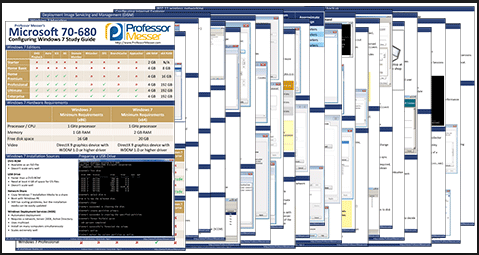
Q. What is the 70-680 Exam: TS: Windows 7, Configuring exam?
A. Microsoft’s 70-680 exam validates your skills and knowledge to efficiently install, configure and manage the Microsoft Windows 7 desktop operating system in an enterprise environment. Candidates are expected to have at least one year of experience in the IT field, as well as experience implementing and administering any Windows client operating system in a networked environment. The TS: Windows 7, Configuring 70-680 exam provides credit towards MCTS: Windows 7, Configuration.
Related More 70-680 pdf Informations:https://www.pass4itsure.com/70-680.html
Official Site:https://www.microsoft.com/en-us/learning/exam-70-680.aspx
